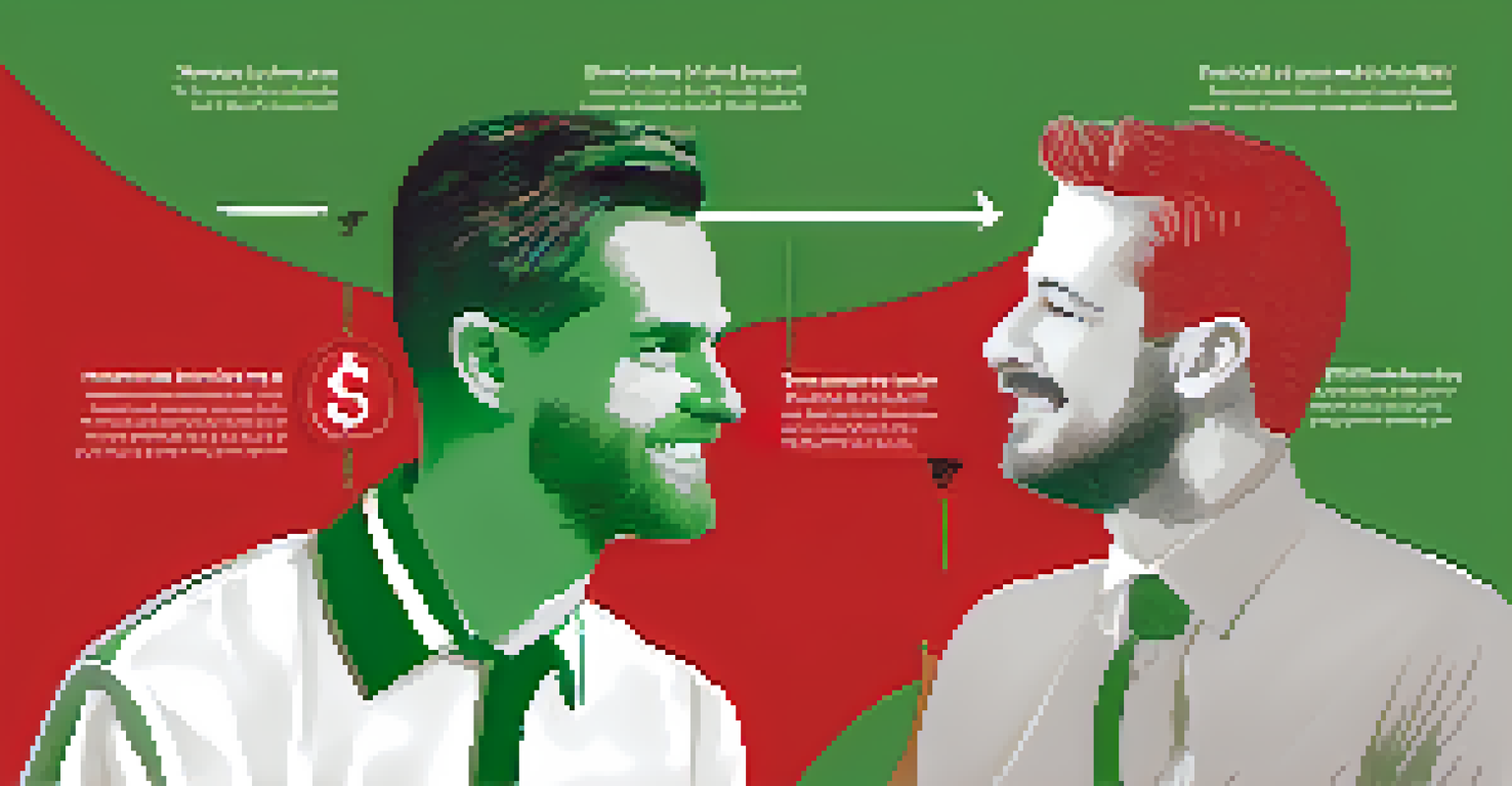Framing Effect: How Presentation Influences Financial Choices

Understanding the Framing Effect in Decision-Making
The framing effect refers to the way information is presented, which can significantly influence our choices. For instance, a financial product described as having a '90% success rate' feels more appealing than one with a '10% failure rate', despite both statements conveying the same information. This psychological phenomenon highlights how our perceptions can be swayed based on context and wording, making it crucial to understand in financial contexts.
The way information is framed can significantly impact decision-making and behavior.
Research has shown that people are more likely to take risks when options are framed in terms of potential losses rather than gains. This means that marketers and financial advisors can manipulate framing to nudge clients toward specific decisions. By presenting information in a way that resonates emotionally, they can encourage choices that might not be made under different circumstances.
Ultimately, recognizing the framing effect empowers consumers to make more informed financial decisions. By being mindful of how information is framed, individuals can avoid falling prey to persuasive tactics and instead focus on the actual value of their choices.
Examples of Framing in Financial Marketing
Financial institutions often use framing to make their products seem more attractive. For example, a credit card advertised with a 'no annual fee' might overshadow the fact that it has high-interest rates. This selective presentation can lead consumers to overlook important details that affect their financial health.

Another common example is the way savings plans are presented. A plan that states, 'You could earn $1,000 in five years' versus one that says, 'You will lose out on $1,000 if you don’t invest' can lead to different responses. The latter framing taps into loss aversion, making individuals more inclined to invest to avoid missing out.
Framing Influences Financial Choices
The way information is presented can significantly sway our financial decisions, emphasizing the importance of awareness in decision-making.
These examples illustrate how clever framing can influence financial decisions, often without the consumer even realizing it. Understanding these tactics can help individuals critically evaluate financial products before committing.
The Role of Loss Aversion in Financial Choices
Loss aversion is a key concept tied to the framing effect, referring to our tendency to prefer avoiding losses over acquiring equivalent gains. This psychological bias means that when faced with choices, people are more impacted by potential losses than potential gains. In financial decision-making, this can lead to overly cautious behavior or even irrational choices.
People are not always rational, and their decisions can be influenced by how choices are presented.
For instance, an investor might hold onto a losing stock longer than advisable simply to avoid the pain of realizing a loss. Conversely, they might rush into a high-risk investment if it’s framed as a chance to gain rather than lose. Recognizing this tendency can help individuals make more rational decisions based on the actual potential of investments rather than emotional reactions.
By understanding loss aversion, individuals can counteract its effects through strategies like setting clear goals or employing a structured decision-making process. This way, they can focus on long-term outcomes instead of short-term emotional responses.
How Context Influences Financial Decisions
The context in which financial information is presented can drastically alter decision-making. For instance, if a financial advisor presents a retirement plan alongside a comparison of future lifestyle scenarios, it can help clients visualize their choices more effectively. This contextual framing can either empower or dissuade individuals from taking action based on how appealing the scenarios appear.
Consider a scenario where individuals are shown a projected retirement income of $5,000 per month versus a visual that highlights how much they could potentially lose without saving. The latter framing can create a sense of urgency and encourage proactive saving behaviors. This demonstrates how context can make a significant difference in financial outcomes.
Loss Aversion Affects Investor Behavior
Individuals tend to prioritize avoiding losses over acquiring gains, often leading to irrational financial choices.
Thus, being aware of the context and its influence can help individuals approach financial decisions with a clearer mindset. This awareness allows consumers to evaluate options based on their true merits rather than the emotional weight of the presentation.
Framing Effect in Behavioral Economics
Behavioral economics explores how psychological factors affect economic decisions, and the framing effect is a central theme. This field shows that consumers often act irrationally, driven by emotions rather than cold hard facts. Recognizing this can help individuals understand their own financial behaviors and improve decision-making.
For example, when people are given a choice between a guaranteed $50 or a 50% chance to win $100, many opt for the guaranteed amount due to the framing of 'certainty' versus 'risk.' This insight into human behavior is critical for financial planners and marketers looking to connect with their audience effectively.
By incorporating principles from behavioral economics, financial professionals can create strategies that align with how people naturally think and feel. This alignment can lead to better communication and ultimately more satisfied clients.
Overcoming the Negative Impact of the Framing Effect
It’s essential to develop awareness of the framing effect to make better financial decisions. One effective strategy is to seek out multiple perspectives before making a choice. By comparing different presentations of the same information, individuals can gain a more rounded understanding of their options and reduce susceptibility to framing.
Another practical approach is to ask questions that dig deeper into the details of a financial product. Instead of accepting statements at face value, inquiring about the underlying assumptions can reveal potential biases in framing. This not only helps clarify the real value of a product but also encourages critical thinking.
Context Shapes Financial Decision-Making
The context in which financial options are presented plays a crucial role in how individuals perceive and act on those choices.
Lastly, consulting with a financial advisor who prioritizes transparency can provide valuable insights. A trustworthy advisor will present options clearly, helping clients navigate through the noise of marketing and focus on the best financial strategies for their needs.
Practical Tips for Applying Framing Awareness
To effectively apply the understanding of the framing effect in daily financial decisions, start by consciously evaluating how information is presented. Before making a significant financial choice, take a moment to identify the framing used—does it highlight gains or emphasize losses? This awareness alone can shift your perspective.
Additionally, you can create a decision matrix that lays out different financial options side by side. By visually comparing the pros and cons in a structured format, you can minimize the impact of persuasive framing and focus on what truly matters. This method helps clarify your priorities and values in financial planning.

Finally, don’t hesitate to share your insights with others. Discussing decisions with friends or family can provide alternative viewpoints, allowing you to see how framing might influence their perspectives as well. This collective approach can lead to more informed and balanced financial decisions.